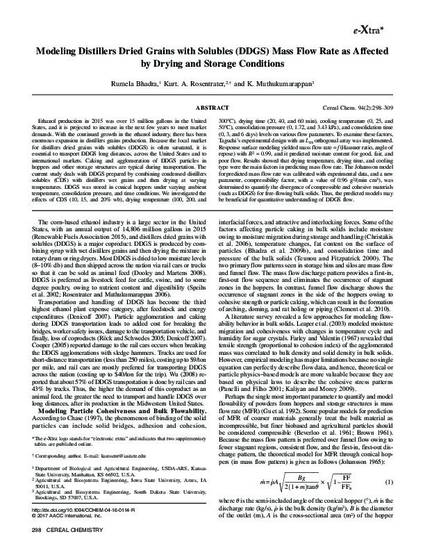
Ethanol production in 2015 was over 15 million gallons in the United States, and it is projected to increase in the next few years to meet market demands. With the continued growth in the ethanol industry, there has been enormous expansion in distillers grains production. Because the local market for distillers dried grains with solubles (DDGS) is often saturated, it is essential to transport DDGS long distances, across the United States and to international markets. Caking and agglomeration of DDGS particles in hoppers and other storage structures are typical during transportation. The current study deals with DDGS prepared by combining condensed distillers solubles (CDS) with distillers wet grains and then drying at varying temperatures. DDGS was stored in conical hoppers under varying ambient temperature, consolidation pressure, and time conditions. We investigated the effects of CDS (10, 15, and 20% wb), drying temperature (100, 200, and 300°C), drying time (20, 40, and 60 min), cooling temperature (0, 25, and 50°C), consolidation pressure (0, 1.72, and 3.43 kPa), and consolidation time (0, 3, and 6 days) levels on various flow parameters. To examine these factors, Taguchi’s experimental design with an L18 orthogonal array was implemented. Response surface modeling yielded mass flow rate = f(Hausner ratio, angle of repose) with R2 = 0.99, and it predicted moisture content for good, fair, and poor flow. Results showed that drying temperature, drying time, and cooling type were the main factors in predicting mass flow rate. The Johansson model for predicted mass flow rate was calibrated with experimental data, and a new parameter, compressibility factor, with a value of 0.96 g2/(min cm3), was determined to quantify the divergence of compressible and cohesive materials (such as DDGS) for free-flowing bulk solids. Thus, the predicted models may be beneficial for quantitative understanding of DDGS flow.
Available at: http://works.bepress.com/kurt_rosentrater/319/

This article is published as Bhadra, Rumela, Kurt A. Rosentrater, and K. Muthukumarappan. "Modeling Distillers Dried Grains with Solubles (DDGS) Mass Flow Rate as Affected by Drying and Storage Conditions." Cereal Chemistry 94, no. 2 (2017): 298-309. doi: 10.1094/CCHEM-04-16-0114-R. Posted with permission.